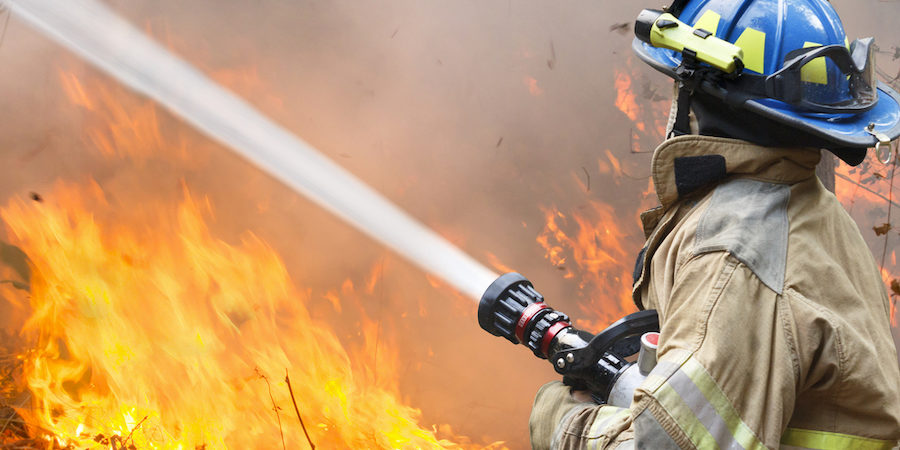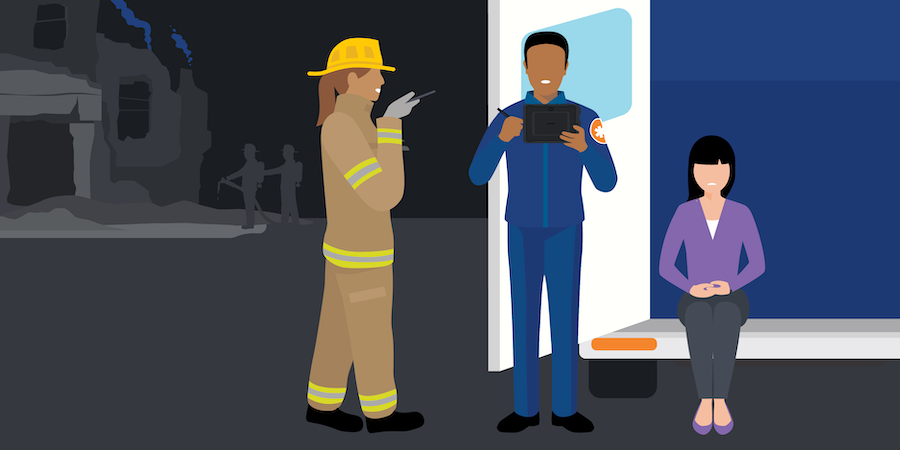As they work to keep their communities safe, fire services face tremendous challenges every day. Fire chiefs have to ensure their firefighters are always ready to go, while lowering their response times.
But many fire departments, particularly in smaller communities, have been short-staffed as a result of budget cuts, both before and after the start of the COVID-19 pandemic. In some cases, fire stations have been forced to shrink their staffs — or shut down entirely. In light of these challenges, fire service operators struggle to maintain adequate training, policy compliance, equipment upkeep and, most worryingly, the safety of responding firefighters and the communities they serve.
Transitioning from legacy communications technology to mobile apps and cloud-based platforms presents an opportunity. Firefighters rely on timely, accurate information to help them make split-second decisions, and their commanders are often inundated with a stream of information that can be difficult to process. Mobile platforms can serve as a force multiplier, allowing fire chiefs and personnel to win back ground against these other operational challenges.
To start, fire chiefs need to choose the right platforms and apps for their team. As they weigh their options, fire chiefs should consider these four critical issues affecting U.S. fire services today:
1. Securing funding and retention
According to the U.S. Fire Administration, the United States is home to almost 1.2 million firefighters, working in 30,000 departments. About 900,000 of them work in volunteer or combination volunteer-career departments. These departments’ fire chiefs rely heavily on their volunteers, as the team can usually respond to service calls with only 10 firefighters or fewer. The safety of the townspeople and the firefighters is jeopardized. Even in career fire departments, many municipalities continue to cut funding, which means these departments have to respond to the same call volumes — or even more — with less staffing.
Low staffing also makes it difficult for fire services to comply with the OSHA requirement that says when two firefighters are inside fighting a fire, two more firefighters must be waiting outside, prepared to rescue them if necessary. There are often inadequate firefighters on scene to address all the necessary functions, including fire attack, search and rescue, ventilation, water supply and rapid intervention.
In volunteer and combination departments, team member retention is also a critical concern. At volunteer fire departments in particular, firefighters don’t have the time to keep up with strict training requirements while working a full-time job and their home life. In North Carolina, for instance, the number of volunteer firefighters has declined by 22 percent in the past two years, according to FEMA. Many other states face similar shortages.
2. Ensuring firefighter safety
According to the National Fire Protection Agency, there were 48 on-duty firefighter fatalities in 2019. Heart attacks remain the leading cause of death for firefighters, as the result of overexertion and stress. Thousands more are injured at fire/incident scenes.
In addition to the more immediate risks of injury and death, firefighters face a 250 percent greater risk of cancer compared to the general population, due to consistent exposure to carcinogens. According to recent research published by the IAFC, an average 63 percent of all firefighters will contract cancer at some point in their lifetime.
Meanwhile, more firefighters are suffering from behavioral health issues (such as anxiety, depression, PTSD and suicidal ideation), and many of them don’t seek help — or lack adequate healthcare access. Their safety training is also often diluted because they have more training topics to cover, and therefore fewer hours spent on each topic. Fire chiefs often lacks the resources and educational programs to help their team members in need.
3. Enhancing fire department communication
Mobile devices and fast, reliable wireless broadband access are presenting exciting new opportunities for fire services. But still, many departments lack the resources to modernize their communications systems. Fire chiefs nationwide have to make a priority of developing their mobile transition plan.
Historically, fire departments have relied on pagers and radio dispatch, but now more and more of them are transitioning to smartphone apps like Active 911 and IamResponding. These apps page firefighters directly on their phone, and they also provide relevant details, such as the type of incident, the address and information from the caller. Departments can also leverage smartphone-based push-to-talk services to augment radio communications and support additional users.
Most dispatch systems are now computerized and use Voice over Internet Protocol (VOIP) to communicate inbound calls to the stations. Extending access to computer-aided dispatch (CAD) systems to mobile apps — rather than just desktops and laptops — helps fire chiefs stay informed while they’re on the go. And the chief or incident commander who’s on scene can quickly determine if they need mutual aid or backup from other departments.
Smartwatches also offer enormous potential for fire services. With advanced sensors that track location, movement and heart rate, wrist-worn devices allow fire chiefs to monitor their team members’ status in real time. They can even receive automated alerts when a team member’s watch detects something concerning, like an elevated heart rate.
4. Coordinating agency resources
When a large-scale emergency occurs, fire services often struggle to coordinate their response. Volunteer and combination departments, in particular, face challenges in securing mutual aid. When a request for additional response or mutual aid is delayed, harm or further loss is likely to increase. When a fire breaks out during normal business hours, many fire departments are short staffed because many of their volunteer firefighters are unable to leave their day jobs. And those who can respond may have to make a stop at their home fire station before traveling to the incident scene, further delaying their response.
Transform fire and EMS with mobility
Take advantage of mobile devices to improve first-responder capabilities with this free guide. Download Now
Fire chiefs’ challenges with interagency coordination are compounded when agencies lack a common communications platform. Agencies’ varying radio systems aren’t always interoperable. Cloud-based platforms offer a potential solution, as they’re easier to integrate with other platforms. As fire chiefs consider which platform is right for their large-scale emergency response plans, they should research their options carefully and consult with neighboring departments.
Rugged devices cut costs — and keep firefighters safe
Fire departments of all sizes and locations are facing higher expectations for their service delivery, including emergency medical services (EMS), active shooter response and more. To rise above these challenges amid reduced funding and smaller staffs, fire departments have to figure out how to do more with less.
Progressive fire departments that have adopted mobile technology like smartphones, tablets and smartwatches are achieving significant operational benefits. Having instant access to safety alerts and other mission-critical information — both in emergency response vehicles and at the scene — can make the difference between life and death. With smart new cloud-based platforms, fire departments receive calls faster and get prompt direction assistance. Dispatchers and 911 operators can also keep responders up-to-date on critical information so they’re better prepared for the incident before they arrive at the scene.
Truly rugged mobile devices — like Samsung’s military-grade rugged tablets — are purpose-built for the kind of intense environment and working conditions that are unavoidable in fire services. These devices also interface efficiently with fire service IT systems like an existing CAD system, extending this information directly to commanders and firefighters seeking the safest and most effective approach to protecting their community.
Transitioning an entire department from manual to mobile doesn’t happen overnight, but you don’t have to be an expert to success. Get Samsung’s tried and true tips for mobilizing fire services in this free guide. And discover more rugged mobile solutions that can take the heat.









